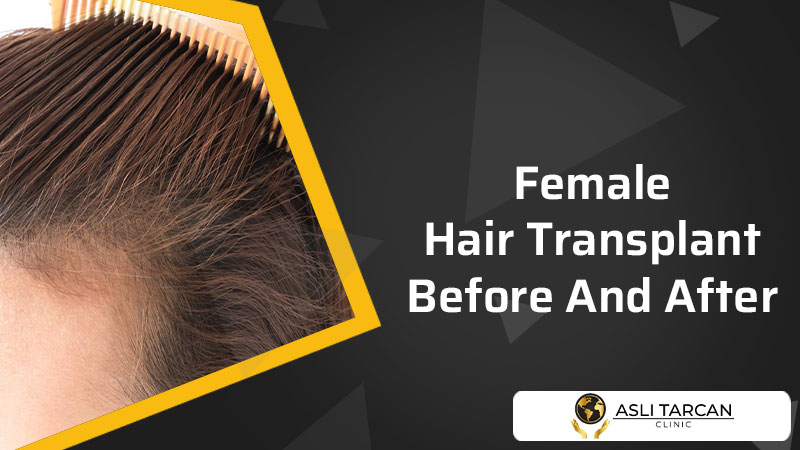Female Hair Transplant Before And After
Female hair transplant before and after congenital, excessive stress, seasonal factors, pregnancy and menopause, nutritional issues, and birth control medicines can all cause hair loss in women. The reason of hair loss should be examined in detail prior to hair transplantation. It will be appropriate to receive a hair transplant after it is determined that male pattern hair loss exists. However, in situations where hair loss is thought to be caused by a disease or another aberration, it would be irrational to have a hair transplant without first addressing the underlying cause.
Hair transplantation in women does not necessitate further shaving. The sparseness can be eliminated and the remaining hair can be filled even if an extra cut is not required. In fact, women are more likely than males to experience the psychological impacts of hair loss. Hair loss affects the majority of males over the age of 30. Society has come to terms with this condition. Hair loss, which affects women at similar rates to males, is less well-known because women conceal their hair loss with wigs or colors. Shedding, on the other hand, receives less notice in women’s hair loss concerns since the front hairline is intact.
Female Hair Transplant Before And After Process
Some tests are conducted on the patient before to the procedure for control and preventative purposes. The evaluation is based on the results (Hepatitis B/C – HIV – Jaundice). Hair is removed from the grafted region, and grafts are obtained from the donor location. The grafts are stored in a solution for organ transplantation. The channels are opened one at a time using cutting-edge technology, and the grafts are placed one by one. The procedure for hair transplantation is carried out after the procedure for hair transplantation has been completed. The patient does not wash for two days, and the institution conducts the initial wash; he is then invite to return to the institution for shedding after ten days.
Within ten days, the patient is doing his own laundry on a daily basis. Every day, after every wash, it returns to its original state. 30–35 percent of the planted area grown in three months. 60-65 percent of development happens in 6 months, and 100 percent growth occurs between the 8th and 12th months, depending on the anatomy of each patient. After transplantation, vitamins can help to preserve the existing hair and brows. Using multivitamin-supported serums with stem cells, in particular, has a lot of advantages. It is vital to pay attention to the lack of chemicals, parabens, and colorants in the shampoo throughout the washing process.
What Makes Female Hair Transplant Different?
When it comes to hair loss in women, the front hairline is still noticeable when compared to males. As a result, the procedure for hair transplantation in women differs. The choi pen method used when hair transplantation is to do between existing hair. Another question that many women have regarding hair transplantation is the cost. In this case, however, a generic pricing table is not possible to create. After all, hair transplantation is a procedure that performed on both men and women. The number of variables is pretty big at this time.
It’s not the same as hair transplantation for guys. Hair transplantation may conduct without shaving the patient using the commonly used FUE procedure. The fue method, which is one of the most advanced hairs transplantation procedures, has improved hair transplantation success in women. In fact, women who suffer from male pattern hair loss are the best candidates for hair transplantation. The success rate will be poor if hair transplant instead of this procedure, despite the fact that it requires medical care. Communication between the patient and the doctor prior to the transplantation procedure is critical at this stage.
While male patients are more likely to discuss the procedure following hair transplantation by expressing remarks, female patients are far less likely to do so. The reason for this is that, in contrast to male hair loss, which widely recognize, female hair loss is not. As a result of the aforementioned, women seldom publish photos of themselves before and after hair transplantation.
Success Rate Of Female Hair Transplant
Women’s hair transplantation procedures are fairly comparable to men’s procedures. Because hair transplantation will do using an unshaved manner, it is vital to wash the hair with care and attention. Because cream use to condition the hair while it washed. It is vital to wash the hair more carefully in order to avoid damaging the transplanted hair, keeping in mind that the cream sticks to the hair. It should, however, does in the clinic where the first wash will perform.
Women recover from hair transplants more quickly. This is due to the fact that the procedure done with an unshaved, semi-shaved approach. Not every woman is a candidate for hair transplantation. So, how well does hair transplantation work in women? When hair transplantation suited for hair transplantation conduct, the success rate is quite high. The doctor determines if it is suitable for hair transplantation. However, following hair transplantation, it is important to wait a year to see the ultimate outcome. The hair is now thickening and maturing in 6-7 months. Furthermore, shock shedding is substantially higher in women than in men. This is due to the fact that women’s hair strands are thinner and softer than men’s.
Female Hair Transplant Costs
Hair from the nape utilize as a donor in hair transplantation, exactly as it is in males. Before undergoing hair transplantation, it is necessary to evaluate whether the loss cause by a medical problem that requires treatment. First and foremost, if hair loss cause by a disease or health concern, therapy should sought. Hair transplantation does not suggest for ladies in such a condition. In fact, if medical assistance is not available, the patient may force to undergo hair transplantation as a last resort.
Another key consideration for ladies considering a hair transplant is the cost. The cost of a hair transplant for a woman varies depending on a number of factors. To begin with, the high expense of grafts in women and the unshaven transplant make the procedure more difficult. As a result, hair transplantation for women is more expensive than for males. As a consequence, the cost of hair transplantation in women varies depending on the doctor’s skill, the quantity of grafts to transplant, and the place where the treatment will conduct.
How Much is a Hair Transplant in Turkey for a Female Foreigner?
A hair transplant in Turkey is becoming increasingly popular for female foreigners due to its affordability and high quality of results. The answer to “how much is a hair transplant in Turkey for female foreigners?” can vary depending on the procedure and the individual’s needs. When considering a hair transplant in Turkey, remember that not all clinics offer the same services or quality of results. Researching different clinics and reading reviews from previous customers is essential to ensure you are receiving the best possible treatment and outcomes.

The cost of hair transplant in Turkey typically includes the surgeon’s fee, anesthesia, medications, a medical evaluation, and pre-operative tests. It is important to note that some clinics may offer additional services, such as post-operative care and medicines, which may incur additional costs. The number of grafts that need to be transplanted and the method used affect the overall price. Remember that a hair transplant is an elective procedure and that there are no guarantees about the results. It is essential to find an experienced and qualified surgeon who can provide you with realistic expectations about the results of your treatment. We hope this article provided insight into “how much is a hair transplant in Turkey for female foreigners?”



